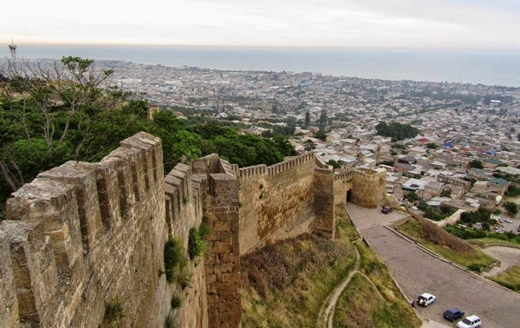In spite of annexation to Russia many years ago, residents of Derbent, a town in the Russian Republic of Dagestan, think of themselves more as Iranian than Russian and such assumption can be easily spotted in the town’s inscriptions.
Derbent was built by Khosrow I, a Sassanid king, when his father Kavadh I (488–531) was on the throne, said Morteza Rezvanfar, a linguist and a member of the Research Center of Iran’s Cultural Heritage, Handicrafts and Tourism Organization.
The following is the translation of an excerpt of his remarks about the ancient town richt.ir has published:
Khosrow I decided to found the town in a bid to fend off attacks by violent tribes and accommodate Iranians in the region. He ordered the construction of a 40-km wall, 20 m in height and 2.5 to 4 m in width. About 12.5 m of the wall still stand today.
The town has a fortress and seven neighborhoods all encircled by a wall which stretches from the fort into the sea where the two ends of the wall meet.
Thirty-two inscriptions in Pahlavi [a middle Iranian language which had currency between 3rd century BC and 10th century AD] edged on the walls of the fortress show its construction time and historical value.
In two villages which are 18 and 40 km away from the town people still speak Pahlavi; of course their language has been affected by Russian and Azeri over the years.
Dari Persian inscriptions which date back to the Safavid and Qajar eras are among tourist attractions of the city.
Each of the seven neighborhoods of this predominantly Shiite Russian town has a mosque with Persian inscriptions.
Unfortunately, the inscriptions have yet to be documented and deciphered by Iranian researchers. Some of the inscriptions have been studied by Russian and Azeri researchers.
The town’s Sassanid fortress and its historical structure were registered as a UNESCO World Heritage Site in 2006. The town is a symbol of the Sassanid civilization; its wall has protected Derbent for 1,500 years.
Because of security concerns, the city is not visited by tourists these days, but throughout history different ethnic groups have always paid attention to Derbent given its strategic position. That’s why Jewish, Christian and Muslim researchers have done a lot of research in this region.
Throughout history, different ethnic groups have invaded the town. For the very reason, there are a lot of villages in the vicinity of the town. They are home to different ethnic groups who speak 30 different languages.
Celebrations to mark the 2000th anniversary of Derbent are to be held in cooperation with eight countries.
Despite the Iranian characteristics of the town, Iran has not been invited to the ceremony and the Iranian cultural attaché in Russia is trying to pave the way for the presence of Iranian representatives in the event.
On my visit to Derbent, I saw gravestones dating back to 2012 and 2013 on which the national emblem of the Islamic Republic of Iran was engraved, a sign which shows that the people of Derbent think of themselves as Iranians.
In my conversations with people of Derbent during my several visits to the town, I realized that they think of Iran as their homeland and yearn for the days when the town was still part of Iran. Even poems on gravestones reflect that profound nostalgia.
